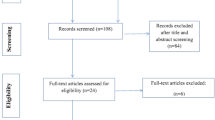Abstract
This study examined spouse correlations in a sample of 93 married couples with respect to 16 interpersonal dimensions using three different data sources: self-report, spouse ratings, and independent interviewer-observer ratings. Results across all three sources supported the previously obtained low positive correlations between spouses. Partial correlations using age and hierarchical multiple regressions using length of marriage do not support the alternative hypothesis that obtained spouse correlations are due to age, to cohort, or to convergence over the course of marriage. Initial assortment is implicated as a probable cause of obtained spouse correspondence.
Similar content being viewed by others
References
Ahern, F. M., Johnson, R. C., Wilson, J. R., McLearn, G. E., and Vandenberg, S. G. (1982). Family resemblances in personality.Behav. Genet. 12:261–280.
Buss, D. M. (1983). Evolutionary biology and personality psychology: Implications of genetic variability.Personal. Individ. Differ. 4:51–63.
Buss, D. M. (1984). Toward a psychology of person-environment (PE) correlation: The role of spouse selection.J. Personal. Soc. Psychol. (in press).
Buss, D. M., and Craik, K. H. (1983). The act frequency approach to personality.Psychol. Rev. 90:105–126.
Buss, D. M., and Craik, K. H. (1984). Acts, dispositions, and personality. In Maher, B. A., and Maher, W. B. (eds.),Progress in Experimental Personality Research, Vol. 13, Academic Press, New York.
Cattell, R. B. (1982).The Inheritance of Personality and Ability. Academic Press, New York.
Cattell, R. B., and Nesselroade, J. R. (1967). Likeness and completeness theories examined by the 16 P.F. measures on stably and unstably married couples.J. Pesonal. Soc. Psychol. 7:351–361.
Christie, R., and Geis, F. C. (1970).Studies in Machiavellianism, Academic Press, London.
Crow, J. F., and Kimura, M. (1970).An Introduction to Population Genetics Theory. Harper & Row, New York.
Eaves, L. J., and Heath, A. C. (1981). Sex-limitation and “asymmetric” assortative mating. In Gedda, L., Parisi, P., and Nance, W. E. (eds.),Twin Research 3: Intelligence, Personality and Development. Liss, New York, pp. 73–86.
Eysenck, H. J., and Eysenck, S. B. G. (1975).Eysenck Personality Questionnaire Manual, Educational and Industrial Testing Service, San Diego, Calif.
Gough, H. G. (1964).Manual for the California Psychological Inventory. Consulting Psychologists Press, Palo Alto, Calif.
Gough, H. G., and Sampson, H. (1974).The General Vocabulary Test, Institute of Personality Assessment and Research, University of California.
Hirschfeld, R. M. A., Klerman, G. L., Gough, H. G., Barrett, J., Korchin, S. J., and Chodoff, P. (1977). A measure of interpersonal dependency.J. Personal. Assess. 41:610–618.
Jackson, D. N. (1967).Personality Research Form Manual, Research Psychologists Press, Goshen, New York.
Jensen, A. R. (1978). Genetic and behavioral effects of nonrandom mating. In Osborne, R. T., Noble, C. E., and Wey, N. (eds.),Human Variation: Biopsychology of Age, Race, and Sex, Academic Press, New York.
Johnson, R. C., Ahern, F. M., and Cole, R. E. (1980). Secular change in degree of assortative mating for ability?Behav. Genet. 10:1–7.
Nance, W. E., Corey, L. A., Rose, R. J., and Eaves, L. J. (1981). Relevance of the marriages of twins to the causal analysis of nonrandom mating. In Gedda, L., Parisi, P., and Nance, W. E., (eds.),Twin Research 3: Intelligence, Personality, and Development, Liss, New York, pp. 61–71.
Phinney, C., and Gough, H. G. (1982).The California Self-Evaluation Scales, 2nd ed., Institute of Personality Assessment and Research, University of California, Berkeley.
Plomin, R., Defries, J. C., and Roberts, M. K. (1977a). Assortative mating by unwed biological parents of adopted children.Science 196:449–450.
Plomin, R., Defries, J. C., and Loehlin, J. C. (1977b), Genotype-environment interaction and correlation in the analysis of human behavior.Psychol. Bull. 84:309–322.
Price, R. A., and Vandenberg, S. G. (1980). Spouse similarity in American and Swedish couples.Behav. Genet. 10:59–71.
Rowe, D. C., and Plomin, R. (1981). The importance of non-shared (E1) environmental influences in behavioral development.Dev. Psychol. 17:517–531.
Spence, J. T., Helmreich, R., and Stapp, J. (1974). The Personal Attributes Questionnaire: A measure of sex-role stereotypes in masculinity and feminity.JSAS Cat. Select. Doc. Psychol. 4:127.
Spuhler, J. N. (1968). Assortative mating with respect to physical characteristics.Eugen. Q. 15:128–140.
Vandenberg, S. G. (1972). Assortative mating, or who marries whom?Behav. Genet. 2:127–157.
Watkins, M. P., and Meredith, W. (1981). Spouse similarity in newlyweds with respect to specific cognitive abilities, socioeconomic status, and education.Behav. Genet. 11:1–21.
Wiggins, J. S. (1973).Personality and Prediction: Principles of Personality Assessment, Addison-Wesley, Reading, Mass.
Wiggins, J. S. (1979). A psychological taxonomy of trait descriptive terms: The interpersonal domain.J. Personal. Soc. Psychol. 37:395–412.
Zonderman, A. B., Vandenberg, S. G., Spuhler, K. P., and Fain, P. R. (1977). Assortative marriage for cognitive abilities.Behav. Genet:7:261–271.
Author information
Authors and Affiliations
Rights and permissions
About this article
Cite this article
Buss, D.M. Marital assortment for personality dispositions: Assessment with three different data sources. Behav Genet 14, 111–123 (1984). https://doi.org/10.1007/BF01076408
Received:
Accepted:
Issue Date:
DOI: https://doi.org/10.1007/BF01076408




